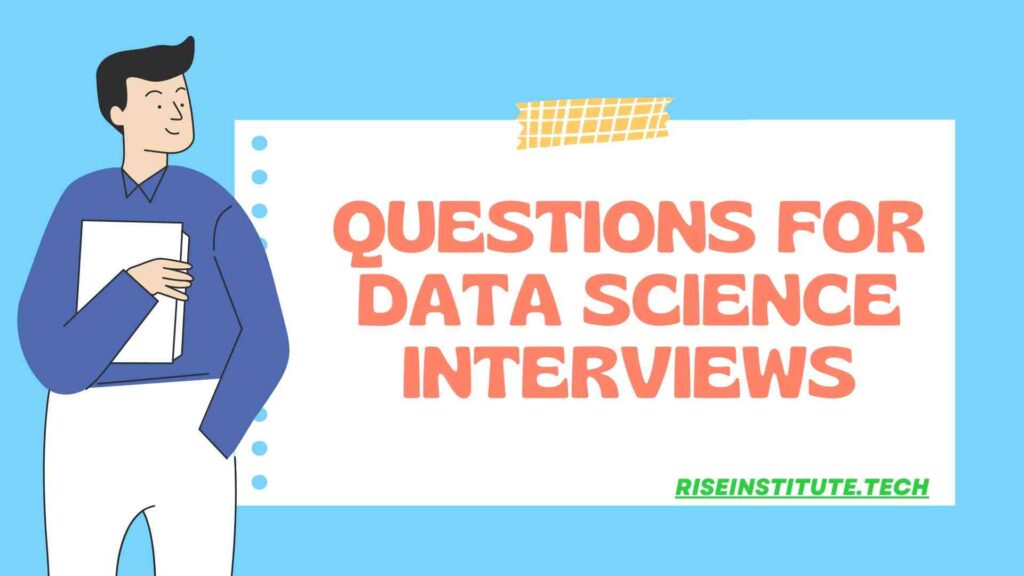Questions for Data Science Interviews
Introduction Data science is an interdisciplinary field that mines raw data, analyses it, and discovers patterns that can be used to extract valuable insights. The core foundation of data science is stats, computer science, machine learning, deep learning, analysis of data, visualization of data, and various other technologies. Because of the importance of data, data science has grown in popularity throughout the years. Data is regarded as the future’s new oil, which, when correctly examined and used, may be extremely useful to stakeholders. Not only that, but a data scientist is exposed to working in a variety of fields, solving real-world practical challenges with cutting-edge technologies. The most common real-time application is fast food delivery in apps like Uber Eats, which assists the delivery worker by showing the fastest feasible path to the destination from the restaurant. Data Science is also utilized in item recommendation algorithms on e-commerce sites such as Amazon, Flipkart, and others, which indicate what items the customer should buy based on their search history. Data Science is becoming increasingly popular in fraud detection applications to detect any fraud involved in credit-based financial applications, not simply recommendation systems. A skilled data scientist can understand data, innovate, and be creative while solving problems that support business and strategic objectives. As a result, it is the most lucrative employment in the twenty-first century. In this post, we will look at the most often requested Data Science Technical Interview Questions, which will be useful for both aspiring and seasoned data scientists. Data Science Interview Questions for New Graduates 1. What exactly is meant by the term “Data Science”? Data Science is an interdisciplinary field that consists of numerous scientific procedures, algorithms, tools, and machine learning approaches that strive to help uncover common patterns and extract meaningful insights from provided raw input data through statistical and mathematical analysis. It starts with obtaining the business needs and related data. After acquiring data, it is maintained through data cleansing, data warehousing, data staging, and data architecture. Data processing is the work of examining, mining, and analyzing data in order to provide a summary of the insights collected from the data. Following the completion of the exploratory processes, the cleansed data is submitted to various algorithms such as predictive analysis, regression, text mining, recognition patterns, and so on, depending on the needs. In the last stage, the outcomes are graphically appealingly communicated to the business. This is where data visualization, reporting, and various business intelligence tools come into play. 2. What exactly is the distinction between data analytics and data science? Data science is the endeavor of converting data via the use of numerous technical analysis methodologies in order to derive useful insights that a data analyst may apply to their business circumstances. Data analytics is concerned with testing current hypotheses and facts and providing answers to inquiries in order to make better and more successful business decisions. Data Science drives innovation by addressing questions that lead to new connections and solutions to future challenges. Data analytics is concerned with extracting current meaning from existing historical context, whereas data science is concerned with predictive modelling. Data Science is a broad subject that uses diverse mathematical and scientific tools and methods to solve complicated problems, whereas data analytics is a narrow profession that deals with certain concentrated problems utilizing fewer statistical and visualization techniques. 3. What are some of the sampling techniques? What is the primary benefit of sampling? Data analysis cannot be performed on a big volume of data at once, especially when dealing with enormous datasets. It is critical to collect some data samples that can be used to represent the entire population and then analyses them. While doing so, it is critical to carefully select sample data from the massive dataset that properly represents the complete dataset. Based on the use of statistics, there are primarily two types of sampling techniques: Clustered sampling, simple random sampling, and stratified sampling are all probability sampling approaches. Techniques for non-probability sampling include quota sampling, convenience sampling, snowball sampling, and others. 4. Make a list of the conditions that cause overfitting and underfitting. Overfitting occurs when a model performs well only on a subset of the training data. When new data is fed into the model, it fails to produce any results. These situations develop as a result of the model’s low bias and high variance. Overfitting is more likely in decision trees. Underfitting occurs when the model is so simplistic that it is unable to recognize the correct relationship in the data and hence performs poorly even on test data. This can occur as a result of excessive bias and low variance. Under fitting is more common in linear regression. 5. Distinguish between long and wide format data. Data in Long Formats Each row of data represents a subject’s one-time information. Each subject’s data would be organised in different/multiple rows. By seeing rows as groupings, the data can be recognised. This data format is most typically used in R analysis and is written to log files at the end of each experiment. Wide Formats Data The repeated responses of a subject are separated into columns in this case. By seeing columns as groups, the data may be recognised. This data format is rarely used in R analysis, however it is extensively used in statistical tools for repeated measures ANOVAs. 6. What is the difference between Eigenvectors and Eigenvalues? Eigenvectors are column vectors or unit vectors with the same length/magnitude. They are also known as right vectors. Eigenvalues are coefficients that are applied to eigenvectors to give them variable length or magnitude values. Eigen decomposition is the process of breaking down a matrix into Eigenvectors and Eigenvalues. These are then employed in machine learning approaches such as PCA (Principal Component Analysis) to extract useful insights from the given matrix. 7. What does it signify when the p-values are high and low? A p-value is a measure of the likelihood of obtaining outcomes that are equal


